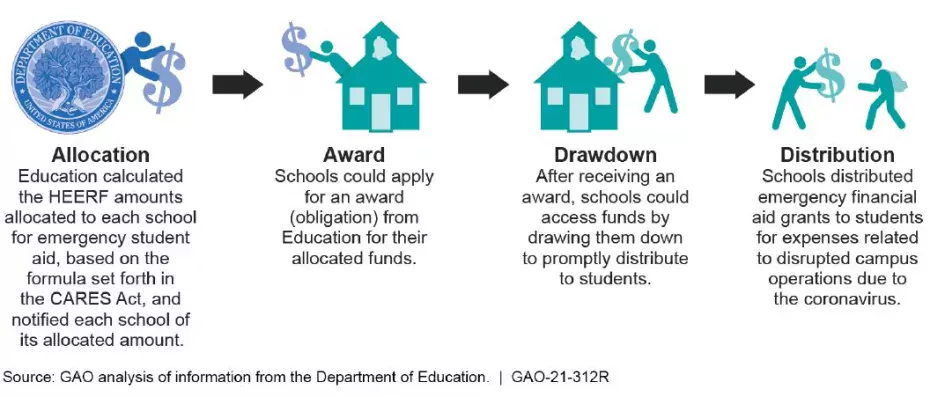Higher Education COVID-19 Relief Funding—Who Got What and What Went Wrong?
Many students faced unexpected expenses for housing, food, technology purchases, and more after colleges and universities closed their physical campuses last year in response to the COVID-19 pandemic. To help students and schools, Congress created the Higher Education Emergency Relief Fund.
Today’s WatchBlog post explores our work on how the Higher Education Emergency Relief Funds were distributed.
About the Higher Education Emergency Relief Fund (HEERF)
HEERF was approved by Congress as part of the March 2020 CARES Act and initially included $14 billion to be administered by the Department of Education (Education).
Most of this funding, about $12.6 billion, was required to be used for grants awarded to individual schools. The schools could use the money to fund general efforts to help them prevent, prepare for and respond to the COVID-19 pandemic. Schools were required to award at least half of that funding—about $6.25 billion—directly to eligible students as emergency student aid for expenses they incurred as a result of the disruptions that the pandemic caused to campus operations.
So, who got what?
The Department of Education identified schools eligible for funding and calculated how much each school could receive based on a formula that considered factors like the school’s share of full-time students who receive Pell Grants—federal grants awarded to low-income undergraduate students. Schools could then apply to Education for the funding. The graphic below illustrates this process.
Image

In April, we reported that as of November 2020, Education had awarded $6.19 billion of emergency student aid to 4,778 schools (out of 5,136 eligible schools)—most of which were public institutions. In addition, we found that 358 eligible schools didn’t apply for the funding. Some of them had significant endowments to draw on instead, and at least one of them closed.
We estimated that by fall of 2020, schools had distributed about 85% of the funds to students, based on a sample of school websites. On average, students received about $830 to cover their unexpected expenses, but a school’s average award amount ranged from $189 up to $2,600. More than half of the schools in our review awarded different amounts based on individual student circumstances—such as a student’s general financial need, whether the student was in a graduate or undergraduate program, or whether the student lived on or off campus.
Schools used different methods to determine student eligibility and award aid. At some schools, students had to complete the federal government’s student aid form—Free Application for Federal Student Aid (FAFSA)—before qualifying for aid. Other schools determined a student’s financial need based on existing information, like whether records showed that the student was eligible for Pell Grants.
Potential payment errors
In July, as part of our on-going CARES Act reporting, we also looked at Education’s efforts to administer HEERF overall, including additional funding Congress approved after the CARES Act, which increased the total relief funding to $76.2 billion.
Education’s Office of Postsecondary Education normally administers about $2 billion in grants in a given year. As of May 31, 2021, 14 months after the enactment of the CARES Act, the office had obligated $66 billion in HEERF funding, which was 33 times the normal amount for the office. While the office was able to use existing staffing levels to get the job done, the unusually large volume of funding and the urgent need to process and distribute it increased the risk of payment errors.
As part of our work, we tested the office’s procedures for approving and processing grants and found that they didn’t include processes needed to identify errors. We estimated that for 5.5% of schools receiving HEERF funding (about 262 of the 4,764 schools within the scope of our review), the office awarded funds that exceeded the amount allocated to those schools. We identified 3 instances where this occurred in the schools we tested, totaling $20 million awarded in excess. The office corrected these errors after we brought them to their attention.
As a result, we recommended that Education design and implement procedures for regularly conducting quality assurance reviews of awarded amounts for all its higher education grants, including those issued through HEERF, to help identify and correct payments made in error. Education agreed with our recommendation and told us it has already established and will continue to enhance its procedures for quality control of grant awards.
- Comments on GAO’s WatchBlog? Contact blog@gao.gov.
GAO Contacts
Related Products

GAO's mission is to provide Congress with fact-based, nonpartisan information that can help improve federal government performance and ensure accountability for the benefit of the American people. GAO launched its WatchBlog in January, 2014, as part of its continuing effort to reach its audiences—Congress and the American people—where they are currently looking for information.
The blog format allows GAO to provide a little more context about its work than it can offer on its other social media platforms. Posts will tie GAO work to current events and the news; show how GAO’s work is affecting agencies or legislation; highlight reports, testimonies, and issue areas where GAO does work; and provide information about GAO itself, among other things.
Please send any feedback on GAO's WatchBlog to blog@gao.gov.





